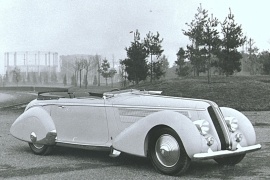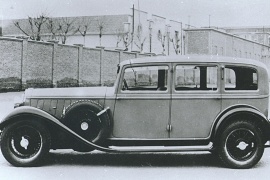LANCIA Astura Models/Series Timeline, Specifications & Photos
First production year: 1931
Engines: Gasoline
Lancia introduced the Astura in 1931 as a more affordable vehicle for the masses. The car was constantly upgraded, almost yearly.
The Astura broke Vincenzo Lancia's ambition to name its cars after the Greek alphabet. After 1922, when the Fascist party of Benito Mussolini won the elections, a strong nationalist movement conquered the country. Lancia thought that it would be wiser to use the name from an Italian island, where ancient Roman villas were built.
The Astura was offered either as a complete vehicle or as a chassis. It was usual for the carmakers to do that, and for the customers to hire coachbuilders to finish their vehicles. The 1933 model was offered as a complete car by Lancia. It was a sedan with four doors that offered enough interior room and style to be considered a premium vehicle. At the front, Lancia installed the electric headlights on the same rim that supported the radiator grille, with its vertical slats.
Regardless of the car was sold as a chassis or complete vehicle, Lancia fitted the car with a three-spoke steering wheel and a dash-panel. The dials were installed in the middle. Vincenzo Lancia considered that the driver should have an individual seat and didn't want to install benches at the front. Moreover, the gearstick was on the floor, next to a lever needed for a fixed accelerator position.
The Astura 1933 was built for a year until 1934, and the latter models featured hydraulic brakes, while the former ones were fitted with cables for the four-drum braking system. Under the hood, Lancia installed a V8 engine for the Astura. A similar-shaped vehicle, but with an inline-four unit, was built especially for authorities and police forces.
Lancia replaced the Lambda lineup with two models: the Astura and the Artena. While the latter was intended as a mass-production vehicle, the former was more exclusive.
The first world major economic crisis of the century wasn't started yet, and the blooming Italian industry made room for wealthier entrepreneurs. Lancia was on the verge of improving its lineup and introduced the Astura as an executive sedan with a powerful engine.
Lancia sold the Astura as a complete vehicle or as a bare chassis, to be completed by independent coachbuilders. The four-door sedan was luxurious and featured rear-hinged front doors and regular ones for the rear passengers. Like most of the Italian cars built in that era, the driving post was on the car's right side so that the driver could see better the road's edge. One specific detail about the Astura was the slightly raked radiator, built to improve its aerodynamics.
Inside, there was room for five adults with plenty of legroom and headroom thanks to the car's high greenhouse. The dash-panel featured center-mounted dials for speed, revs, oil pressure, ammeter, coolant temperature, a clock, and fuel level. In Pininfarina convertible body shape, the Astura still featured the same wheelbase as the sedan, resulting in a true four-seat rag-top.
Under the hood, Lancia installed a V-8 engine with just 17 degrees between the cylinder banks. It was a concept developed by the Italian carmaker since WWI, and it proved to be a good idea. The four-speed gearbox was not synchronized, but the car featured adjustable rear dampers via a turning knob under the dashboard. That was something unusual for luxury cars from that era.

